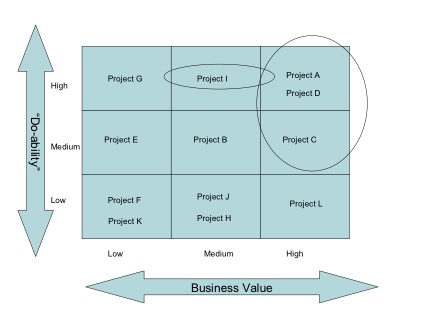By Ron Montgomery, Management Consultant & Owner, OnPoint, LLC
It is easy to spot an organization that operates without clear priorities. Workgroups in such organizations careen from one crisis to another. Political turf battles arise as competing initiatives vie for scarce resources. Morale suffers as the most conscientious employees work extensive overtime just to keep up. The fault lies in the inability of leaders to set priorities.
Why is it so difficult to set priorities? Because setting priorities means making a decision that “Project A” is more important than “Project B,” and the leaders are hesitant to make an incorrect or ill-informed decision.
If you are a manager struggling with competing priorities, here is a simple, step-by-step approach that will help get you started.
Step 1 – Identify the Projects
There may be more projects underway than those of which you are aware. I know of a large organization that identified 175 projects, yet the executive team was aware of only 10. Take some time with your management team to create an inventory of all the projects that are either planned or active.
Step 2 – Assess the Business Value
“Business Value” does not necessarily mean a strong cost benefit analysis calculation. Cost benefit analyses can be misleading because they often rely on questionable assumptions. Business value can be assessed in a more subjective manner by answering the following questions:
- To what extent does this project align with the organization’s goals and strategies?
- To what extent does this project enhance our position with current customers?
- To what extent does this project streamline our operations?
Each project should be rated as High, Medium, or Low with regard to these questions.
Step 3 – Assess the “Do- Ability”
This step provides a rough assessment of the potential risk of the project. This can be assessed by answering the following questions:
- Have we ever successfully completed a project such as this?
- Will this project take less than 9 months to complete?
- Does this project have a strong sponsor?
Each project should be rated as High, Medium, or Low with regard to these questions.
Step 4 – Plot the Results and Make Your Choices
Plot all of your projects on a matrix such as the one listed below and circle those which provide the best combination of business value and do-ability. Projects that do not “make the cut”, but still have strong business value should be re-planned to reduce their risk profile and be re-prioritized during the next planning cycle.

There are more sophisticated methods for evaluating a portfolio of projects. But if you are just getting started, this simple, straightforward approach will help you focus your organization. It will also immediately reduce the level of stress and chaos you may be experiencing.
Written by Ron Montgomery,
Project Management Expert for ManagingAmericans.com, Management Consultant & Owner, OnPoint, LLC